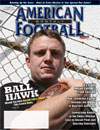Article CategoriesAFM Magazine
|
Onside Every Time - Sam Nichols Turns the Tables by Making His Kickoff Team an Offensive Unitby: John GallupEditor and Publisher © More from this issue In last November’s Michigan Division 4 district title game, underdog South Haven, trailing 7-3, began the second half with an onside kick. What seemed like a very risky strategy paid off, as the Rams recovered the kick, scored on the ensuing possession and held on for a 16-7 victory. It was the first playoff win and first district title in school history.
|
|
|||||||
| HOME |
MAGAZINE |
SUBSCRIBE | ONLINE COLUMNISTS | COACHING VIDEOS |
Copyright 2025, AmericanFootballMonthly.com
All Rights Reserved





